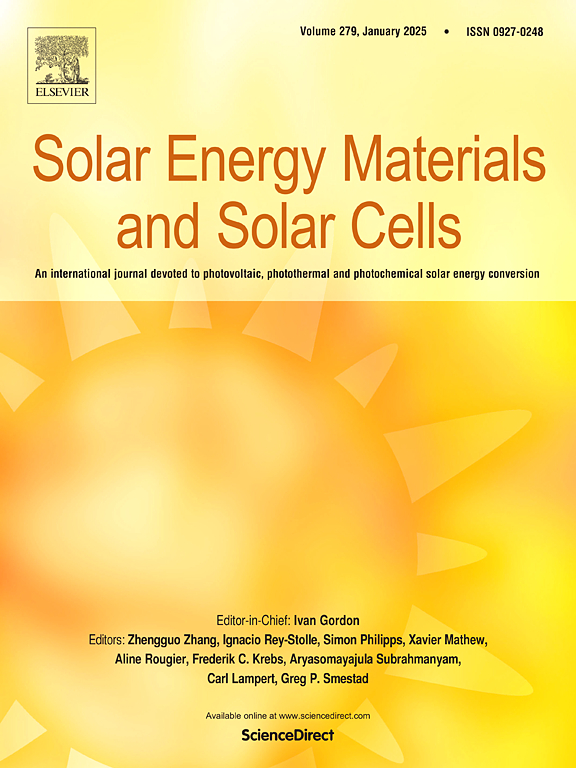Role of hydrogen dynamics and deposition conditions in photochromic YHO/MoO3 bilayer films
IF 6.3
2区 材料科学
Q2 ENERGY & FUELS
引用次数: 0
Abstract
Oxygen-containing yttrium hydride (YHO) and molybdenum trioxide (MoO3) bilayer films (YHO/MoO3) are produced using reactive magnetron sputtering, and their photochromic properties are investigated in relation to the thickness and density of the MoO3 layer. Compared to single YHO films, the YHO/MoO3 films exhibit faster coloration and larger contrast, with both parameters adjustable by varying the thickness or deposition pressure of the MoO3 layer. Transparent YHO/MoO3 films (∼75 % at 550 nm) demonstrate a photochromic contrast of up to 60 %, significantly higher than the 25–30 % contrast observed for single YHO films after 20 h of UVA-violet light exposure. This enhancement arises from hydrogen intercalation from the (200)-textured polycrystalline YHO film into the X-ray amorphous MoO3, leading to the formation of molybdenum bronze (HxMoO3), as confirmed by X-ray photoelectron and optical spectroscopies. However, the darkened YHO/MoO3 films do not fully recover to their initial transparency after illumination due to the irreversible nature of the coloured MoO3 layer. Most of the hydrogen intercalated into MoO3 originates from the YHO layer during the initial darkening process. Furthermore, the bilayer films are chemically unstable, exhibiting gradual darkening over time even without intentional UV illumination, as confirmed by nuclear reaction analysis.
氢动力学和沉积条件在光致变色YHO/MoO3双层膜中的作用
采用反应磁控溅射法制备了含氧氢化钇(YHO)和三氧化钼(MoO3)双层膜(YHO/MoO3),并研究了其光致变色性能与MoO3层厚度和密度的关系。与单一的YHO薄膜相比,YHO/MoO3薄膜具有更快的显色速度和更大的对比度,这两个参数可以通过改变MoO3层的厚度或沉积压力来调节。透明的YHO/MoO3薄膜(在550 nm处约75%)显示出高达60%的光致变色对比度,显著高于uva -紫外光照射20小时后观察到的单个YHO薄膜25 - 30%的对比度。x射线光电子和光谱学证实,这种增强是由于氢从(200)织构的多晶YHO膜插入到x射线无定形MoO3中,导致钼青铜(HxMoO3)的形成。然而,由于有色MoO3层的不可逆性,暗化的YHO/MoO3薄膜在照明后不能完全恢复到最初的透明度。在初始变暗过程中,嵌入到MoO3中的氢大部分来自于YHO层。此外,核反应分析证实,双层膜在化学上是不稳定的,即使没有故意的紫外线照射,也会随着时间的推移逐渐变暗。
本文章由计算机程序翻译,如有差异,请以英文原文为准。
求助全文
约1分钟内获得全文
求助全文
来源期刊

Solar Energy Materials and Solar Cells
工程技术-材料科学:综合
CiteScore
12.60
自引率
11.60%
发文量
513
审稿时长
47 days
期刊介绍:
Solar Energy Materials & Solar Cells is intended as a vehicle for the dissemination of research results on materials science and technology related to photovoltaic, photothermal and photoelectrochemical solar energy conversion. Materials science is taken in the broadest possible sense and encompasses physics, chemistry, optics, materials fabrication and analysis for all types of materials.
 求助内容:
求助内容: 应助结果提醒方式:
应助结果提醒方式:


